Nautical Charts
- A Brief History
- Producing U.S. Nautical Charts
- More Than 1,100 Charts!
- Nautical Charts in the Digital Age
- Growing Uses for Nautical Charts
A Brief History of Nautical Charts
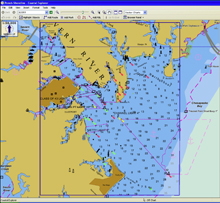
Computer screen display of an electronic navigational chart in the Chesapeake Bay. Click image for larger view.
Nautical charts have evolved for hundreds of years. Beginning with the late 13th century portolan1 charts of the Mediterranean Sea, through the first atlas of nautical charts produced by the Dutch seaman and cartographer Lucas Janszoon Waghenaer in 1584, to the electronic nautical charts of today, nautical charts have kept pace with technological advances. They are now part of the digital age.
Over time, charts have become more accurate as new technologies improved the hydrographic surveys that are necessary to create nautical charts. Just like Waghenaer’s early cartographic masterpieces, today’s charts depict coastlines, islands, rivers, harbors, and features of navigational interest such as water depth, hazards, and aids to navigation. Throughout their history, nautical charts have held great economic, military, and diplomatic value. In fact, they were often treated as national or commercial secrets and either classified by governments or held as proprietary information by great commercial enterprises such as the Dutch East India Company.

: Dutch seaman and cartographer Lucas Janszoon Waghenaer produced the first sea atlas (cover above) of nautical charts in 1584. Experts recognize Waghenear charts to some of the most handsome ever produced.
President Thomas Jefferson realized the importance of nautical charts to commerce and the security of the young United States and ordered a “survey of the coast” in 1807. The Survey of the Coast2, the organization established to carry out Jefferson’s vision, has been the official chartmaker of the United States for the last 200 years.
Nautical charts and the underlying information used to create them are some of the earliest products and data sets associated with NOAA and its ancestor agencies. Collecting the underlying data began in 1816 with geodetic surveys in New Jersey and New York and in 1835 with hydrographic surveys of New York Harbor. The Coast Survey published it first nautical chart in 1844. Many of the Coast Survey’s earliest nautical charts are now part of its Historical Map and Chart Collection. We also suggest taking a few moments to browse a collection of some of the Coast Survey's earliest charts of New York Harbor that grace the pages of this Web site.
Producing U.S. Nautical Charts
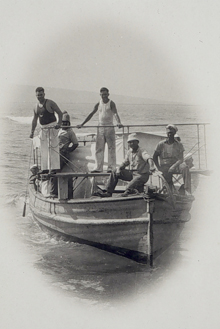
The Coast Survery cast lines weighted with lead well into the 1920s to measure water depths on its hydrographic surveys. Click image for larger view.
Starting in the 1800s, the Coast Survey created nautical charts by using several sets of interrelated information collected by geodetic, topographic, tidal, and hydrographic survey field parties. The geodetic parties produced an interlocking network of precisely surveyed points on land through a process called triangulation; the topographic parties constructed maps of the shoreline and near shore areas; tidal parties observed the rise and fall of tides and tidal currents in the area to be charted; and the hydrographic survey parties took depth soundings in offshore waters and used the geodetic and topographic information to determine the position of sounding vessels.
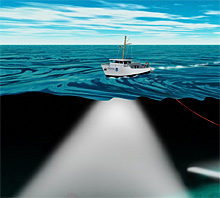
Multibeam sonar (illustrated below the ship) was a major breakthrough in hydrographic surveying and a quantum advance from the lead line. Data acquired with multibeam sonar have revolutionized human understanding of the seafloor and the efficiency of NOAA's Office of Coast Survey offshore surveying in support of nautical charting.
Until the 1920s, hydrographic surveyors primarily used lead lines to determine depths. They corrected their observed depths relative to a tidal datum (reference elevation). Draftsmen plotted all of this information on paper at a scale for chart production. Engravers transferred the details from the paper to a copper plate. Printers then used the engraved copper plate to reproduce the chart on paper for distributing to mariners.
Over time, all of these processes and equipment advanced with evolving technology such as: improved geodetic instruments; aerial photographs for shoreline maps; acoustic depth-sounding instruments; advances in navigation that culminated in methods for differential global positioning; and changes in printing and reproduction techniques from copper plates, to glass and plastic scribe coat plates, to today’s computer cartography.
Producing and Maintaining More Than 1,100 Charts!
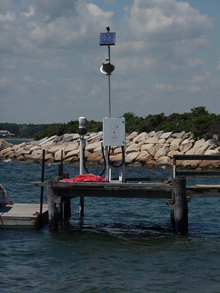
Producing nautical charts relies not just on hydorgraphic surveys and onshore positioning. It also requires water level observations made by tide measuring stations (above) in order to correct depth sounding data relative to a tidal datum. Click image for larger view.
Today, NOAA’s Office of Coast Survey and its sister offices, the National Geodetic Survey and the Center for Operational Oceanographic Products, collect marine navigation data from a multitude of sources in addition to NOAA’s own hydrographic survey data. The Coast Survey combines these intertwined data and technologies to construct and maintain its suite of 1,100 charts, nine Coast Pilot publications, and related marine products necessary to safely navigate the nation’s waterways. These nautical charts cover over 95,000 miles of shoreline, including the Great Lakes, and about 3.4 million square nautical miles of the U.S. Exclusive Economic Zone, an area that reaches 200 miles offshore.
The nautical charts are the end products of enormous volumes of underlying data and field survey work. During the period that NOAA and its predecessor organizations have produced nautical charts, coast surveyors estimate the underlying data and work include:
- 14,000 compiled shoreline maps;
- 160 years of tidal observations at hundreds of locations;
- 76,000,000 million soundings from hydrographic surveys;
- 11,500 hydrographic surveys; and
- more than 1,000,000 geodetic positions.
Nautical Charts in the Digital Age
Computer technology plays a vital role in compiling the diverse data sets necessary for creating nautical charts today. This technology has allowed the Coast Survey to produce and distribute new products such as raster charts, beginning in 1990, for use in electronic navigation systems. Raster navigational charts (RNCs) are digital pictures of paper charts. Georeferencing and other digital data are added to the pictures to enable the RNCs to display a ship’s position in real-time over a familiar charted background. The Coast Survey distributes updates weekly over the Internet to correct the RNCs for critical changes such as newly discovered wrecks or relocated aids-to-navigation.

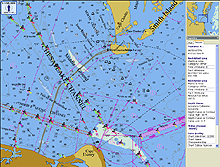
Raster navigational chart (left) and electronic navigational chart of the same area at the mouth of Chesapeake Bay. NOAA produces raster navigational charts by scanning electronically at high resolution the original color separates that are used to print the paper charts. Electronic navigational charts are created from a database of chart objects and their attributes. The objects may be turned on and off when the chart is displayed on a computer screen. Click image for larger view.
In 1997, the Coast Survey began producing a more advanced type of digital chart called the electronic navigational chart (ENC). Each chart is a database of chart objects and their attributes. With the right computer software, mariners can view the data in a chart-like display on a computer screen. Like raster charts, ENCs are geo-referenced and can display a ship’s position in real-time over its display. More significantly, since ENCs contain data rather than simple chart images, electronic navigation systems can use them to look ahead for approaching dangers ("Channel bears left in 1,000 yards!"). They will automatically trigger alarms based on the ENC data ("Shoal ahead!"). Users can turn chart objects off or on to simplify a computer screen display when appropriate. Like it does for raster charts, the Coast Survey produces and distributes weekly digital updates to the ENCs.
Both types of electronic charts, when used in computer-based navigation systems, offer route planning and monitoring tools that were previously unavailable. Integrating electronic charts with radar and with Automated Identification System (AIS) data about other vessels in the area provides a sophisticated “situational awareness” tool that reduces the chances of a collision or grounding and improves navigation efficiency. Both types of electronic charts are also usable in geographic information systems by coastal zone managers, scientists, and environmentalists.
The NOAA Office of Coast Survey, with a handful of other charting organizations, has played a leading role in developing electronic charts. It has also taken a prominent position in writing and adopting international standards for RNCs, ENCs, and the electronic navigation systems that use them.
Growing Uses for Nautical Charts
Over the years, the role of nautical charts has grown with the dramatic technological changes used to produce them. For 200 years their primary function has been to provide mariners–commercial fishers, ship pilots, recreational boaters, and the military–with a means to navigate safely and efficiently. Coast Survey nautical charts were vital to several war efforts, most notably the Civil War, World War I, and World War II. During the Civil War, the Union used the charts and the underlying data to plan and execute blockades, which contributed to Union success. During World War II, the Coast Survey provided almost 100 million charts and maps to allied forces. Coastal managers today use the charts and their underlying data sets increasingly as planning tools and for studying changes in the marine and coastal environment over time. First responders use them in emergency response operations during oil and hazardous material spills.
1. From the Italian, porto, meaning, 'port.' Portolan charts were hand-drawn charts and sailing directions between ports along with descriptions of harbors and coasts.
2. The Survey of the Coast was later renamed the U.S. Coast Survey and, in 1878, the U.S. Coast and Geodetic Survey. Today, its title is the Office of Coast Survey.










